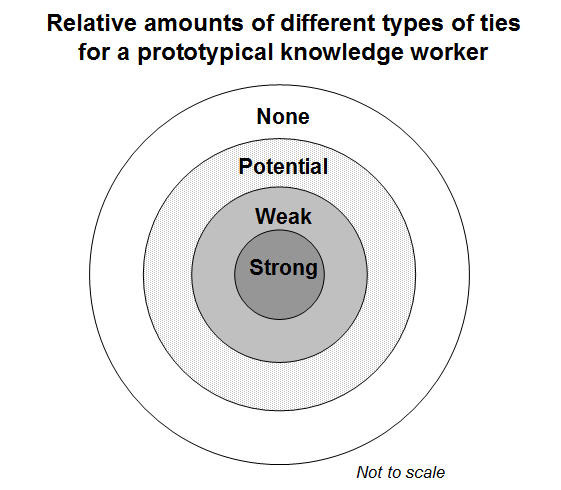Category: Uncategorized
How to Hit the Enterprise 2.0 Bullseye by @amcafee
I mentioned Andrew McAfee and his book ‘Enterprise 2.0’ in an earlier blog post and would like to come back to him now. In Chapter 4 of his book, Andy introduces the notion of the Enterprise 2.0 Bullseye (see below graph). The logic of the bullseye builds on Granovetter’s (1973) and Burt’s (1992) work on the strength of weak ties and structural holes. Andy argues that the bullseye helps to focus Enterprise 2.0 efforts by distinguishing the different types of ties between people, or employees, and how these ties may be maintained or altered by the use of social software (which he calls ESSPs). Cooperation between close colleagues, or strong ties, may be facilitated by wikis, whereas social network sites are more suitable to maintain a large network of acquaintances, or loose ties. Blogs, in turn, are seen to be enablers for converting potential into actual contacts. Last but not least, there are forms of cooperation, for example in the case of prediction markets, when no tie between actors is present and yet the individuals involved can productively interact. There are a number of other studies that investigate the impact of ICT on social capital, yet Andy manages to match ties and technologies. This is an interesting step forward.

Granovetter, M. S. (1973). The strength of weak ties. American journal of sociology, 78(6), 1360.
McAfee, A. (2009). Enterprise 2.0: New Collaborative Tools for Your Organization’s Toughest Challenges. Harvard Business School Press.
The most prolific authors in the field of social network analysis
Below is an account of the most prolific authors in the field of social network analysis as recorded by Otte and Rousseau in 2002. The authors were ranked according to the numbers of publications in the Sociological Abstracts database. I have linked the names to the researchers’ websites and included their Twitter accounts, if avaible, in parentheses. Alternatively, you can also visit their profiles on the INSNA website. If you know of any more recent references or are aware of similar studies from different academic disciplines, I would certainly love to hear from you. Similarly, I would like to know whether I’ve missed anyone who’s already on Twitter.
Wellman, Barry (
Skvoretz, John
Bonacich, Phillip
Everett, Martin G.
Willer, David
Burt, Ronald S.
Friedkin, Noah E.
Borgatti, Stephen P. (@ittagroB)
Johnsen, Eugene C.
Faust, Katherine
Otte, E., & Rousseau, R. (2002). Social network analysis: a powerful strategy, also for the information sciences. Journal of Information Science, 28(6), 441.
The History of Social Network Analysis
While I did come across a lot of technical writing about social network analysis to this date, I wasn’t lucky enough to stumble upon the works of Linton C. Freeman and Steve Borgatti until fairly recently. Professor Freeman has written a complete book on the Development of Social Network Analysis and Professor Borgatti and his colleagues have published a paper that serves as an overview to Network Analysis in the Social Sciences. Both are worth a read and I thought I’d share the links with you. Enjoy!
Workshop: Business Applications of Social Network Analysis
- The role of data mining techniques in identifying scalable methods for the extraction and organization of social relations for management research and business practice
- The role of management research in guiding data mining efforts and SNA metrics development towards theoretically-grounded discoveries about social network emergence.
- The role of Social Network Analysis in developing and applying metrics and tools for the mapping, evaluation, visualization, and design of social relations in organizations.

